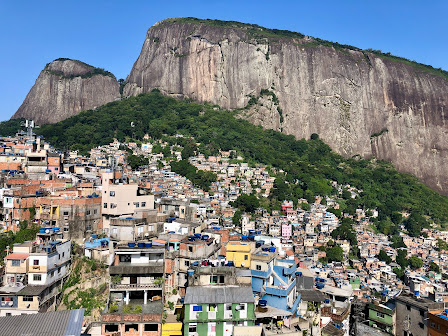The Favela Rocinha is the Safest Place in Rio De Janeiro
During our trip to Rio de Janeiro, we toured the largest favela in South America, Rocinha, which is home to about 180,000 people. Approximately 80,000 of those residents live on less than $15 USD per day. The name "favela" comes from the tree under which recently freed African slaves slept when the government reneged on their commitment to provide homes to slaves who fought for Brazil against Paraguay in the 19th century. More than 150 years later, the favelas have become more permanent homes to the Brazilian working class. It is a self-sufficient city within a city.
In Brazil as in several other South American countries, wealthier people built their homes closer to the beach. In the U.S. we might think that hilltops overlooking the water would be highly desirable areas for real estate development with their sweeping views, but it was historically extremely difficult to build in those areas. Much of this land was government owned and untouched. So, many favelas are the result of poorer populations squatting on that land and slowly building up constructions over time. Since they don't technically own the land, few government services are provided, and there is some risk that the government could kick them out. Over time, however, favela dwellers have gained some rights, and this is still an area at the forefront of local politics.
Our guide, a tall, lanky man over 50 years old who could have beaten any of us 30-something tourists in a foot race or mountain climb, was from Rocinha. He has been giving tours for years. He learned English as a kid from studying the dictionary as a way to escape the abuse and neglect of his adopted parents. He was a fiercely proud man who insisted that, if nothing else, we take away these three lessons from the visit:
1. His favela is one of the safest places in Brazil
2. All favelas are different
3. We can now say we have visited the "real" Brazil
Like many poor neighborhoods across the world, very few locals visit if they don't have to. There are so many stereotypes about the favelas that our guide wanted to dispel, most notably that they are crime-ridden, unsafe neighborhoods. In fact, he said, this is the only place in Rio where residents can feel comfortable keeping their doors unlocked. Everyone looks out for each other, protects one another, and respects their belongings. They can't rely on anyone else and don't have access to many governmental services, so they band together to take care of the favela. As we looked around, we noticed that despite the apparent poverty, everyone was wearing clean, well-kept clothes. Our guide told us that the number one business in the favela are the hardware stores--as poor people build their houses in increments as they get more money--but the second most successful businesses are barber shops, as people like to keep themselves well groomed and looking good.
Overall, the tour was extremely optimistic. It focused on the community, resilience, and pride of the favela. However, there is no doubt that people are living in poor conditions. The homes closer to the street are more desirable as they have easier road access and possibly even a real address to which they can receive mail. The farther residents are from the street, the more steep stairways and tiny alleys they have to climb through to get to their doors. They have almost no natural light and live by the almost prison-like lights that spotlight the dank conditions. These lights and the other electrical amenities that residents receive are kept on by a truly terrifying tangle of cables that would make any electrician's head spin.
At the end of the tour, our guide took us to a hole-in-the-wall bar that had "the best caipirinhas in Rio", in his opinion. As we sat outside (there were no doors in the bar) watching the passersby and the wall-hung TVs that looked like they were from the early 2000s, we sipped our drinks. I don't know if it was the best caipirinha I had in Rio, but it was certainly the strongest! As we left the bar after one drink, I found myself loosely walking down the sloped street casually chatting with my friend about the tour as mopeds, bikes, and small trucks squeezed uncomfortably close to us.








Comments
Post a Comment